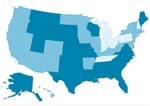Health
Osteoporosis drug prevents breast cancer
■ Preliminary results indicate raloxifene works as well as tamoxifen against invasive cancer and with fewer side effects but is not as effective against noninvasive types.
By Victoria Stagg Elliott — Posted May 8, 2006
- WITH THIS STORY:
- » Tamoxifen vs. raloxifene
- » External links
- » Related content
Raloxifene appears to prevent invasive breast cancer as well as tamoxifen does while causing fewer adverse events, according to the preliminary results from the Study of Tamoxifen and Raloxifene trial.
Experts say this finding, which was released by the National Cancer Institute last month, may herald the beginning of the era of chemoprevention for this disease.
"This optimistic news from STAR is a significant step in breast cancer prevention," said John E. Niederhuber, MD, deputy director of the NCI, the study's sponsor.
The trial, one of the largest breast cancer prevention investigations ever, randomized nearly 20,000 postmenopausal women at high risk of the disease to receive either daily doses of tamoxifen or raloxifene. According to the NCI statement, both tamoxifen and raloxifene cut the risk of invasive breast cancer in half. Both drugs were also equally good at maintaining bone density. Women on raloxifene, however, had fewer uterine cancers, blood clots and cataracts -- all of which are associated with tamoxifen.
"We're declaring raloxifene the winner," said Lawrence Wickerham, MD, associate chair of the National Surgical Adjuvant Breast and Bowel Project, the study's organizer.
Researchers hope that some stumbling blocks in terms of breast cancer prevention will now be reduced. Tamoxifen has had a great deal of success as an adjuvant treatment for this disease but has not made many inroads as a preventive.
The reasons are mainly because of the drug's side-effect profile and the perception that it is primarily a cancer treatment. Therefore, it has been rarely used in the primary care setting where most prevention work takes place.
The facts that raloxifene has a better risk profile and that many primary care physicians already use it for osteoporosis treatment and prevention leads experts to believe it may have more success at reducing the breast cancer rate.
"The reality is that tamoxifen is not used as much as we would have liked it to be," said Leslie Ford, MD, NCI associate director for clinical research in the division of cancer prevention. "This should compel primary care physicians to have a discussion with their female patients about things they can do to reduce their risk of breast cancer just like they talk to them about heart disease."
Digesting the data
Physicians responded positively to the release of these results because patients already on raloxifene for osteoporosis can now be assured they are getting the additional benefit of reducing their breast cancer risks.
It also means there is another option for patients who are at high risk but do not want to take tamoxifen.
"It's exactly what we hoped for," said JoAnn V. Pinkerton, MD, professor of obstetrics and gynecology at the University of Virginia School of Medicine in Charlottesville. "We have been waiting a long time for the results of this study."
Many, however, expressed caution. There is a great deal of concern about the fact that raloxifene does not appear to do as well at preventing noninvasive cancers.
Tamoxifen reduces the risk of lobular carcinoma in situ and ductal carcinoma in situ by half, but raloxifene does not appear to do the same.
These types of cancers are rarely deadly but they do increase the risk for invasive breast cancers which are. Treatment is also not an inconsequential concern.
"These are not trivial diagnoses. These cancers don't usually go on to kill, but women still have to undergo treatment which is not a day at the beach," said Sofia Merajver, MD, PhD, one of the study's principal investigators and director of the Breast and Ovarian Cancer Risk and Evaluation Clinic at the University of Michigan in Ann Arbor. "It's nice for women to have a choice, but there's no clear winner."
Raloxifene has also not been approved by the Food and Drug Administration for breast cancer prevention, although the drug's manufacturer, Eli Lilly and Co., issued a statement saying approval would now be sought.
Both Eli Lilly and AstraZeneca Pharmaceuticals, which makes tamoxifen, provided their respective drugs and placebos at no charge to participants.
Eli Lilly also provided $30 million to defray recruitment costs and support local investigators.
Meanwhile, most physicians are also waiting for the full results to be published in a peer-reviewed journal, expected before the end of the year, in order to dig deeper into the data before deciding to change how they use raloxifene. The data will also be presented at the American Society of Clinical Oncology meeting in June.
"We are limited to the information that has come out," said Len Lichtenfeld, MD, deputy chief medical officer for the American Cancer Society. "It will take some time for experts to review the data to determine which of the two treatments is preferable."
But while researchers say that this opens a door to a new era, they also say this is hardly the final chapter in the story of chemoprevention of breast cancer.
At least a half-dozen cancer preventives are currently at some stage in the clinical trial process, and experts say that there is still a desperate need for drugs that can prevent estrogen-receptive negative cancers, which tamoxifen and raloxifene do not, and for drugs with even better risk profiles.
"The message should not be, 'great, we're done,' " said Judy Garber, MD, MPH, one of the study's principal investigators and director of the cancer risk and prevention program at the Dana-Farber Cancer Institute in Boston. "We still have plenty to do."












